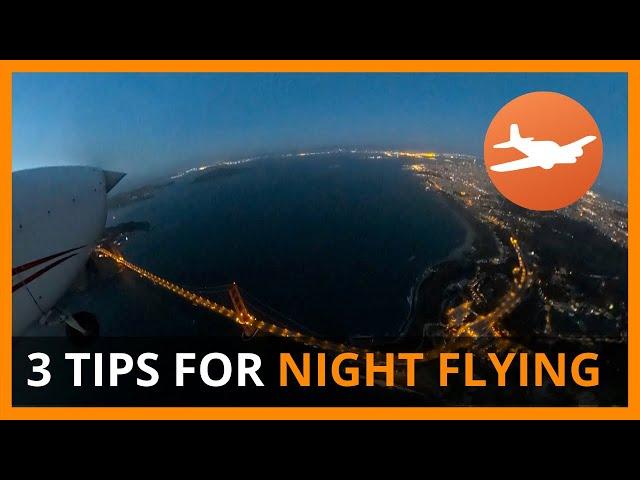
LEARN NIGHT FLYING - 3 Flight Instruction Tips. The thrill of the night that ALL pilots should know
Комментарии:

I would go for the water, thanks man
Ответить
Here in Canada you must earn a night rating to be allowed to fly at night. It’s a min of 10 hours with an instructor and no test, but it’s still extra training. I’m also instrument rated, and I truly consider night flying to be instrument flying. I wonder though whether there is a different in the rate of night VFR accidents in Canada vs the US.
Ответить
I haven't done any night recurrency since I moved out of the Bay Area, so I'm 21 years overdue. I have a digitized video from my old PAO days on my channel of this event: Amy and I went to Livermore for my birthday dinner at the old Red Baron restaurant (no drinks!). Flew back to PAO as wisps of clouds were appearing over the spine of the Peninsula. Didn't like my first approach; went around and landed. By the time I made it to the PAFC tiedown, there was a solid low overcast covering the field. That was a lesson strongly learned!
Ответить
Nice to see some videos on night flying! I just got my Night Rating here in Vancouver BC, and really enjoying it. The extra instrument training and hood time was really valuable. Watch out for the mountains, there's no lights on them!
Ответить
In the Bay Area agreed, water but with a few thou of altitude, you can glide to a lot of places. Chrissy field used to be an airfield ;-). I also know the beach is likely to be deserted at night. Also at Reid-Hillview, Palo Alto and Hayward, the three places I fly most, I have areas I've walked that I plan to go to if I suffer engine failure at takeoff. Walking around and seeing the ground really helps with awareness for planning landings. A trick I pulled over to GA from hang gliding.
Ответить
Use ForeFlight on aerial view to get a look at what you are landing into???
Ответить
Jason, Loving your channel but i have to be ticky tack here being a veteran. Ive been watching your videos and when you give the time you say OH900 etc. That was a noh noh in the military its pronounced as zero nine hundred. Each time you say Oh i here drop and give me 20. LOL keep up the good work Teach & Learn always!
Ответить
Water for sure
Ответить
Terrain and place make for huge differences in operations. In Australia, much of a pilots night flying is across ink blank darkness. There will be lights in the distance of a small town or cattle station but basically, on a moonless night, your only option is to turn the landing light on and you'll know what your landing on when it picks up the ground.
Ответить
Great tips Jason.
I did my rating in Toronto in the middle of winter some years back & the contrast between downtown & lake ontario was amazing to see.

Recent student pilot, but I've been dimming the dash lights on my car when driving at night since day one.
Ответить
I immediately thought water - that's where I'd go.
Ответить
Good thoughts Jason... the areas here in North East Texas come with some "gotchas"... NE Texas is covered in pine timber (100' tall), hardwood bottoms, wetlands and lakes. At night the lakes and forested areas look the same from the air especially w/o GPS with a moving map and/or ForeFlight pulled up... And the towns and/or larger cities are spread out 15 - 20 miles apart and others are 20+ miles apart with nothing but darkness between them with a few scattered lights of farms and/or outlying subdivisions near major roads. As some of these road have lights along them and very limited traffic at night, it sometimes can become a better option for us here in this area.
Ответить
Night flying is unique. All other aircraft are easily seen in the air (thanks to nav lights), unlike during the day. It is peaceful and a little eerie enroute. Once over the city you have to be careful not to stare at the lighting too much. Landing is a little trickier Autokinesis where stationary lights can appear to move. False horizon created by varying light heights. For remote airports, the black hole effect trips up judging distance and height.
Ответить
Yeah for night I would plan my route along some major highways or shoreline! It'll be a no-go for me when neither of them is available
Ответить
I'd gi for the water
Ответить
Jason, always spot on with your tips. Good VID
Ответить
Just came across your channel and it's great. You asked about where others would head for at night in the event of an engine failure. I obtained my PPL in Melbourne Australia 1979 and I have an enormous amount of hours at night. My personal opinion is unless you are totally familiar with the dark patches on the ground as I would be in Melbourne I would not head for those at all. The chances of a building/house with no lights on or row of gum trees is too great. Hitting one of those at 85Kts in a G36 or a 182 would most likely be certain death. Yes but you must protect the innocent on the ground as you say. A highway/freeway as we call them here would be my 1st pref, followed by large ports/docks/rivers/beach next. I guess if you are nowhere near a city or lit up area then it may be the only choice. As we always say, turn the landing/taxi lights on at 300', if you don't like what you see, turn them off again !, Great show you have my subscription. Cheers.
Ответить
Love your channel
Taking notes for my CFI lesson plan

I was thinking in a dense city like that the water could very well be your best option, especially if there is a protected bay or similar where the water is smooth as glass. Even if there is a park or baseball field, there could be tall obstacles that could make a safe approach difficult.
Ответить
I'm in the process of becoming night rated and found this useful. Thank you.
Ответить
Hey Jason, great topic. I enjoy night flying but other pilots have me worried. I don't think I could ditch into darkness. I would go for a large road or something. Could you explore other options in a vid? Also I know you used to fly out of PWK, I fly out C77, all farms around. Don't know it its trees or corn. If you are ever in the area and wanna fly lemme know, got a beautiful 150J.
Ответить
Flying at night SEL purely for pleasure is in my opinion foolish. In the event of engine failure you, and your passengers are likely doomed.
Ответить
Flashlights. One is none, two is one and three is better. Green in the cockpit is better than red, and it won’t destroy night vision.
Edit: The first rime I departed MRY and coasted out over water at night I was really glad I had an instrument rating.

The most scariest time I would consider would be flying at night single engine IFR. If you have an engine failure even in VFR, sometimes it is very hard to see anything on the ground as far as powerlines, trees or other obstructions that are not lit. Otherwise night flying is beautiful.
Ответить
What are those lights at 2min in?
Ответить
the golden gate!!
Ответить
last night at about 9pm I got to my airport in Mansfield Louisiana and none of the lights worked. Not even the beacon. I was about to divert 35 miles to shreveport but pilots there helped get electricity back on. I had to circle for an hour in pitch black night
Ответить
Got night current last night 😊
Ответить
Great!
I liked the water option also.

Water into shoreline
Ответить
Soccer field
Ответить
Would be going for the water for sure….. I wouldn’t risk a road with traffic in it, or a park that might have some sort of constructions, statues, kids playgrounds etc in it
Ответить
excellent video as always... as far as where to land in event of engine failure over a densely populated area at night... oh man hopefully you planned ahead of time and are at least vaguely familiar with the escape routes available. or like you said aim for the dark areas as a last resort... terrible choice to have to find yourself in though ahh?
Ответить
The football field. They would think you were just part of the half time act.
Ответить
Go to the emptiest road, don't play around going to the darkest area or sea. what now if the darkest area is a forest or mountain, or houses that are not lighted up or a tremendous bit hole whatever you name it, ahmmm
Ответить
Thank you for making this video, these tips are great, night flying is what I love the most
Ответить
I like the water as well
Ответить
If no water body nearby, a known open land eg farmland, golf course etc is an option
Ответить
Just watched this after reading about a recent crash at night in La Jolla CA. Thank you.
Ответить
Freeway is actually quite safe. Highway system was built in part for airplanes
Ответить
Good tips! Thanks!
Ответить
I would go for the hills behind my house, no power lines, houses or trees.
Ответить
Suppose I'd go for the water, too 👍
Ответить
I just completed my first night flight as a student pilot and loved it. Granted, smooth air and cooler temps is much better than 100F on the ground with gusts and thermals in the Texas Summer. I asked my instructor how engine failure is handled at night. The main takeaway from our convo was that altitude = options. Looking ahead, I will plan night cross country flights at the highest reasonable altitude for the route, consider requiring a certain minimum ceiling, and try to include lighted airfields within gliding distance of my course as best as I can.
Ответить
My first option would be any airport. I could see within sight including any grass field that is a restricted site. I would also turn on every light to include taxi and landing light. This might be a good idea to install deer lights or an LED bar on top of the wing, lol.
Ответить
20501 Quigley Coves
Ответить
Great video! To have an engine out and land into unknown blackness is quite possibly a death sentence. Unless you know its a field or whatever. Just land on the less busy road. Give you and your passengers a fighting chance to live. Everyone's aware when they get into their cars and go drive on the road, they are taking a risk with their life. They expect they might collide with a another car or truck so what's the difference if its a plane that day instead hahah To each their own
Ответить
WATER, WATER, definitely Water 🌊
Ответить










![Imagine Dragons - Machine [ cover by Alex Orlov ] Imagine Dragons - Machine [ cover by Alex Orlov ]](https://invideo.cc/img/upload/NE93UGtyMVozdTg.jpg)